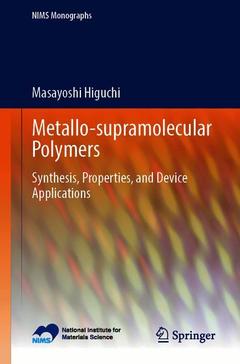Description
Metallo-Supramolecular Polymers, 1st ed. 2019
Synthesis, Properties, and Device Applications
NIMS Monographs Series
Author: Higuchi Masayoshi
Language: English
Subject for Metallo-Supramolecular Polymers:
Publication date: 11-2019
89 p. · 15.5x23.5 cm · Paperback
89 p. · 15.5x23.5 cm · Paperback
Description
/li>Contents
/li>Biography
/li>Comment
/li>
This book introduces the synthesis, electrochemical and photochemical properties, and device applications of metallo-supramolecular polymers, new kinds of polymers synthesized by the complexation of metal ions and organic ditopic ligands. Their electrochemical and photochemical properties are also interesting and much different from conventional organic polymers. The properties come from the electronic intra-chain interaction between the metal ions and the ligands in the polymer chain. In this book, for example, the electrochromism that the Fe(II)-based metallo-supramolecular polymer exhibits is described: the blue color of the polymer film disappears by the electrochemical oxidation of Fe(II) ions to Fe(III) and the colorless film becomes blue again by the electrochemical reduction of Fe(III) to Fe(II). The electrochromism is explained by the disappearance/appearance of the metal-to-ligand charge transfer absorption. The electrochromic properties are applicable to display devices suchas electronic paper and smart windows.
Introduction.- Fe(II)-based metallo-supramolecular polymers.- Ru(II)-based metallo-supramolecular polymers.- Co(II)-based metallo-supramolecular polymers.- Zn(II)-based metallo-supramolecular polymers.- Cu(II)-based metallo-supramolecular polymers.- Pt(II)-based metallo-supramolecular polymers.- Ni(II)-based metallo-supramolecular polymers.- Mo(VI)-based metallo-supramolecular polymer.- Cd(II)-based metallo-supramolecular polymer.- Eu(III)-based metallo-supramolecular polymer.- Summary.
Masayoshi Higuchi
National Institute for Materials Science (NIMS), Tsukuba, Japan
National Institute for Materials Science (NIMS), Tsukuba, Japan
Summarizes metallo-supramolecular polymers concisely in one volume Presents wide-ranging aspects of metallo-supramolecular polymers—their history, synthesis, electrochemical/photochemical properties, and device applications Includes many figures and detailed explanations that are easy for beginners to understand
© 2024 LAVOISIER S.A.S.
These books may interest you

The Role of Topology in Materials 116.04 €



